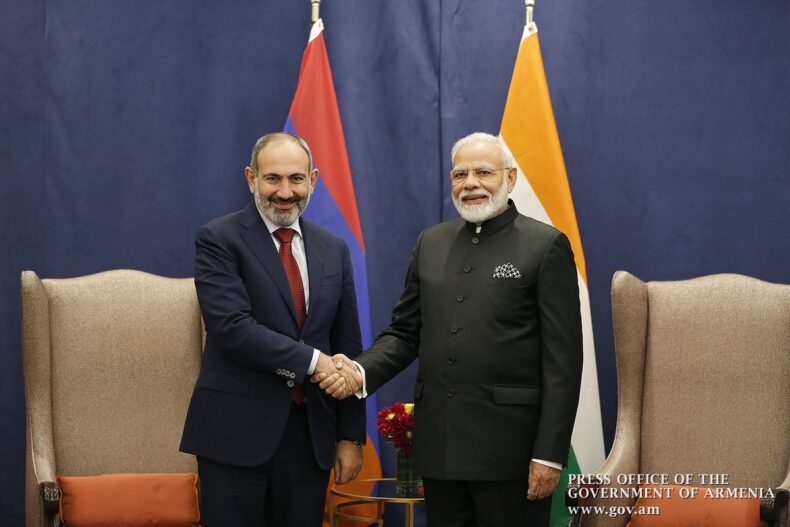The Azerbaijan and Armenia tensions don’t seem to settle anytime soon. In a recent development of violence from Azerbaijan’s side, Armenia has decided to procure arms from the Indian Government.
Earlier this year, Pinaka Mark I Enhanced and Pinaka Area Denial Munition (ADM) were launched on 9th April, from the Army Test Range at Pokhran. The user trials were done on 24th August.
India will be exporting rockets, missiles, and other arms which include Pinaka, an indigenous multi-barreled rocket launcher.
Both Armenia and Azerbaijan have accused each other of violation of the ceasefire that both signed this month.
The Ministry of Defense had cleared the exporting deal of weapons through the “government-to-government” pathway, under which both the countries agreed to deliver ammunition to Armenia earlier this month.
The amount of this deal hasn’t been disclosed yet but it’s being told by the sources that the deal amounts to around 2000 crore rupees. The quantity hasn’t been revealed yet but the order consists of arms, missiles and Pinaka rocket launchers.
Increased efforts in Arms Export
This is one of the significant changes in Government policy and their efforts in increased arms export.
In 2021-2022 fiscal, India’s defence exports were around Rs 13,000 crore, which was 8 times more than what it was around five years ago.
This is not the first time India has exported weapons to Armenia. Earlier in 2020 too, India left its competitors behind in the supply of four Swathi radars estimating Rs 350 crores.
Azerbaijan is seen as growing relations with Turkey and Pakistan and thus forming a new axis.
It has used Turkish drones to fight against Armenia and is also in negotiations with Pakistan for JF-17 fighter aircraft.
Pinaka Rocket Launchers

The Pinaka Multi-Barrel Rocket Launcher (MBRL) is a multiple rocket launcher developed in India for the Indian Army
It consists of a free-flight artillery rocket. The Mark I model has a range of 40 kilometres max and the enhanced ability to launch up to 60 kilometres.
The Armament Research and Development Establishment (ARDE), a laboratory of the DRDO has designed the Pinaka MBRL.
The ARDE, located in Pune, is the main DRDO lab that develops conventional armaments.
Pinaka Mark-I and Mark-II comprise
- a replenishment-cum-loader vehicle, a replenishment vehicle,
- a multi-tube launcher vehicle,
- and a command post vehicle.
- The rocket launcher consists of two pods containing six rockets each which can neutralise an area of 700 × 500 sq m within 48 seconds.
Earlier this year, Pinaka Mark I Enhanced and Pinaka Area Denial Munition (ADM) were launched on 9th April, from the Army Test Range at Pokhran. The user trials were done on 24th August.
The Yantra India Limited, a Nagpur-based defence company is manufacturing The Pinaka ADM.
Armenia-Azerbaijan Conflict

- The conflict between the Christian majority Armenia and Muslim majority Azerbaijan is not a recent one but centuries old.
- However, the current conflict started when Stalin conquered the significant regions of the Caucasus.
- Furthermore, Stalin placed the Nagorno-Karabakh region in Azerbaijan though the region was Armenian-dominated.

- As USSR began to collapse in the 1980s, the fight between the two countries started to increase.
- In 1991. the Armenians from that region declared independence after three years-long battle.
- By 1994 Armenia was successful in removing the Azerbaijan army from the Nagorno-Karabakh region. It caused a huge number of casualties and displacement.
- Russia did try to impose a ceasefire that year but failed.
- Although the Nagorno-Karabakh region is recognized as Azerbaijani territory, the region is largely dominated by ethnic Armenians and controlled by separatists.
- The current crisis started in 2020 and had left more than 6000 dead after a six-week-long war.
- In March, Azerbaijan seized Armenian-dominated Farukh due to its strategic importance.
- In April EU did try to mediate and resolved peace but on the 3rd of April, Baku was accused of killing an Armenian soldier.












